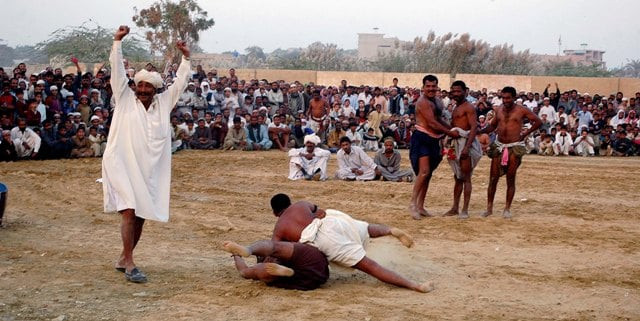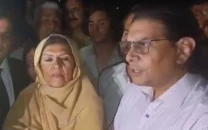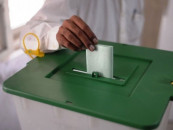Malakhra lives on, thanks to a mulh-titude of reasons
The ancient form of wrestling continues to defy time even after 5,000 years

A HAPPY REFEREE: The referee waves his arms in the air as two mulh wrestlers grapple. PHOTO COURTESY: ABID ARSHAD
Behram comes from a long line of malakhra wrestlers, growing up with the sport and now growing old with it. For Behram, keeping alive the sport of his forefathers is motivation enough for his endeavours to promote it.
While people dismiss malakhra as a small-time local sport not worth their time, Behram and at least 2,000 others across Sindh find it a way to connect with their roots.
“It’s our identity,” Behram, a former international wrestler and local malakhra champion told The Express Tribune. “I work as an official now, organising tournaments with the Sindh Sports Board, but this sport is not as small or as insignificant as many believe it to be.”
Behram believes his passion for the game comes from the history associated with it. “It’s like wearing the history of our land with the sandhra [the cloth mulh wrestlers wear during the fight]. It is an honour and a tribute to forgotten champions, but it is also a passion and a skill that is to be found nowhere else but here.”
Behram started participating in the sport in 1970, following in the footsteps of his father Muhammad Umer. He believes he can now impart the same skill to his 18-year-old son Abdul Jabbar Guldasto, but his other sons do not wish to continue with the family sport.
“I began playing malakhra during Zulfiqar Ali Bhutto’s time,” said Behram. “I began training in Nasrpur, a small town near Hyderabad. I live in Karachi, but that’s what malakhra entailed, to travel to the heart of Sindh to learn this skill.”
Behram’s son Guldasto, who won the silver medal at the recently concluded NBP Cup, is now being taught by his father. “We forge our bond like that, while my other son doesn’t want to play malakhra and works at a company. All you need is one person in a generation to carry on the tradition; it’s beautiful to us,” said Behram.
The father and son train every day to ensure the tradition lives on, beginning from sunrise and making sure that the prodigy runs for at least three kilometres before exercise.
“I teach Jabbar what I learnt so he doesn’t have to go to Nasrpur. We start the training after Fajr prayers; there is running involved and then exercise,” he said. “But the most important routine is oiling and the diet.”
Behran explained that every mulh wrestler needs to oil his body on a daily basis to ensure strength and agility during the fight. “Oiling is essential, if we don’t oil our body, we will not have the strength. It can be any oil though,” said Behram.
Meanwhile, he said that it takes at least Rs1,000 a day to maintain a good diet of the wrestler. “Mulh wrestlers need meat, almonds and desi ghee in their diet,” he said. “Those who can afford this continue on with the sport but many quit because of the financial constraints.”
However, the wrestling form is more than just brute strength. “Malakhra is a technical sport, there are 32 locks that can be used to defeat an opponent,” he said. “The origins of this sport are from Japan, but we see traces of it in the ruins of Moen Jo Daro as well.” Meanwhile, Sindh’s top wrestler Mukhtiar Almani believes that competing in the sport is a matter of honour for him as his forefathers have been playing for generations, and he too wishes to have a son who can continue the tradition.
“When I have a son, I’ll wish him to be a malakhra wrestler too,” said Almani. “It’s the respect that we get. In Sindh we get many competitions, and the top mulh players get Rs3,000 to Rs4,000 per tournament. We have competitions at different shrines, during the festivals there; it’s all very encouraging,”
However, he believes that malakhra needs recognition and the players should be sponsored. “Many of the players are farmers; they have their own land and they work on it, but then there are people like me, who don’t have much money, but we play anyway,” said Almani. “More tournaments will be good for us. I’ve grown up listening to stories that malakhra is as old as the first human settlements in Sindh and I’m a part of that history too.”
And so the tradition of malakhra continues, being gifted from father to son through the ages. It may go relatively unnoticed by many in the country, but for these few men, it means everything.
Like Sports on Facebook, follow @ETribuneSports on Twitter to stay informed and join in the conversation.



















COMMENTS
Comments are moderated and generally will be posted if they are on-topic and not abusive.
For more information, please see our Comments FAQ